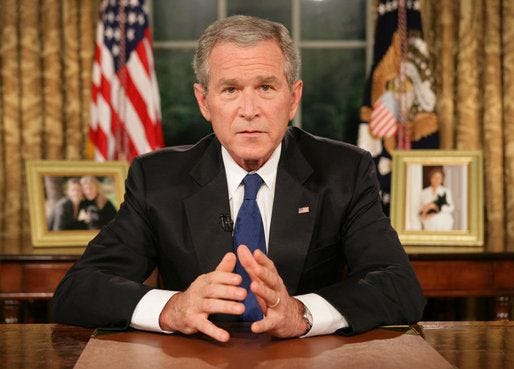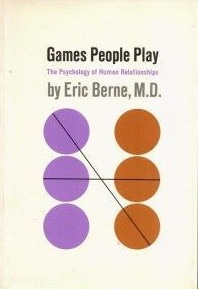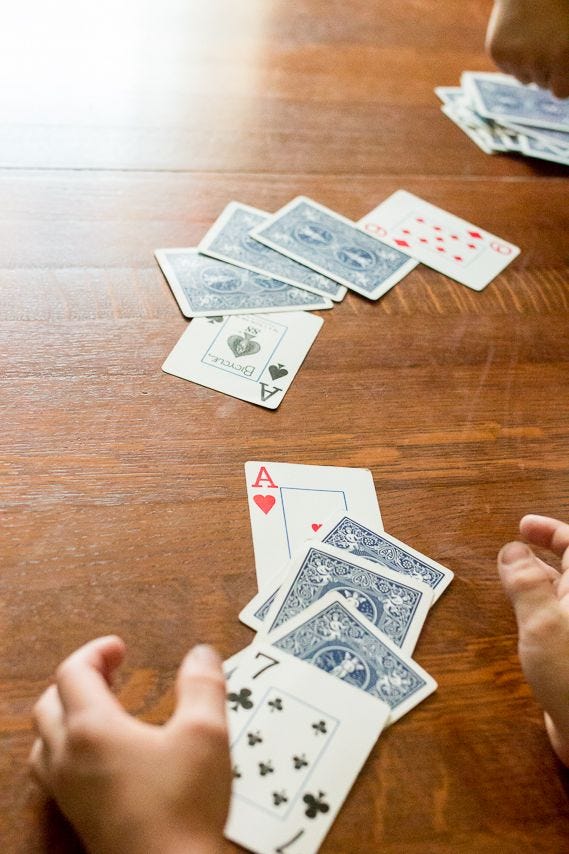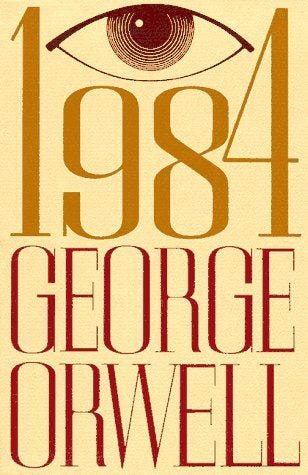Dear subscribers,
This post is shaping up to be the beginning of the game section for the manuscript Games Fascists Play: The Psychology of Supremacy. The formatting mirrors the chapters of Eric Berne’s Games People Play. Admittedly, this post/game was hurried. The impetus to post this section is because the so-called “war on terror” is back in full swing (and I’m procrastinating on book proposals). By the way, “terrorism” is a legal term and should not be dealt with via “war.” The next game (which I will post soon) is Hide & Seek. The War game version of H&S utilizes an analysis of the U.S. war on terror.
-Andrew (1/6/25)
WAR GAMES
The war state needs enemies to sustain itself. When an enemy can’t be found, an enemy is manufactured […] The full-throated cries for war, echoed shamelessly by the press, are justified by draining the conflict of historical context, by elevating ourselves as the saviors and casting whomever we oppose, from Saddam Hussein to Putin, as the new Nazi leader. [i]
-Chris Hedges, The Greatest Evil is War
As the Connection role (Green), the U.S. has engaged in constant warfare and regime change operations since the WWII defeat of the axis powers, i.e., members of Nazi Germany, the kingdom of Italy, and imperial Japan. U.S. War games are here described as deceptive cons (Hide & Seek), provocational maneuvers (Kick Me), enclosures (Occupation), retaliatory revenge (Now I’ve Got You, You Son of a Bitch!), proxy wars (UGOFIGHT) as well as domestic political games (Immigration and Emigration) and individualized forms of fascist violence (Mass Shooter and OMG).
LET’S YOU AND HIM FIGHT
U.S. interventionism has been very effective in building neo-imperialism, keeping the land, labor, natural resources, and markets of Third World countries available at bargain prices to multinational corporations. [i]
-Michael Parenti, Blackshirts and Reds
Set up: Let me connect you so those two can play UGOFIGHT!
Clinical explanation: Fascism is never what it seems. It is not always violent, but decisively manipulative as it utilizes a politics of despair and fear while eliminating the private self. The twentysomething Black lives with her boyfriend (White) and their female roommate (Green). Green is in the Connection role. Here, she provided the flirtatious ammunition for both Black and White to fight over. Deceptively, Green has a coup in mind.
Eventually, White asks Black if she would consider a group sexual conquest with Green. White conceals that they want to perpetuate a war. In this sense, White echoes the response of George Bush II after 9/11: you are with us or you are against us. The ulterior motive for White is that he hopes the relation-state with Black will weaken and deteriorate over time from the ensuing battles. For their part, Green seeks to profit from the escalation of violent exchanges between White and Black. Green openly or secretively will share their desire for regime change of Black: “Let’s You and Him Fight!”
Original game: Original game: Eric Berne described the interpersonal Let’s You and Him Fight (LYAHF) as a maneuver, a ritual or a game. The maneuver of Let’s You and Him Fight (LYAHF) has White set up a competition for her with two men fighting. The winner decamps with White to “live happily ever after.” The ritual of LYAHF is “tragic,” because the two men fight over White even if she is not interested in them:
If the wrong man wins, she must nevertheless take him. In this case it is society and not the woman who sets up LYAHF. If she is willing, the transaction is an honest one. If she is unwilling or disappointed, the outcome may offer her considerable scope for playing games, such as ‘Let’s Pull A Fast one on Joey’.
The game version of LYAHF is comical. White arranges the competition for her, “and while the two men are fighting, she decamps with a third.” This approximates the War game version in that White’s internal psychology (psychopathic) is “derived from the position that honest competition is for suckers” (see FOOLS game).
Berne described the LYAHF game as “essentially feminine” with romantic and therefore dramatic qualities: “LYAHF is the basis of much of the world’s literature, both good and bad.” The War game version is titled UGOFIGHT and shares the characteristics of manipulation and conflict. This game shares similarities (drama and violence), but it is essentially masculine and is the basis for the world’s warfare.
Thesis: The self-possessiveness of capitalism incentivizes relational competition: “Let’s You and Him Fight,” is the ethos of Capitalism games. The War game version of Let’s You and Him Fight (LYAHF) is referred to in the more aggressive UGOFIGHT. As with fascism, misrepresentation (con) is part of the invitation to the game. For example, Nazism presented itself as national socialism. This con initially disguised the imperial nature of Hitler and his fanatics who aimed to save capitalism and not the German citizens.
In UGOFIGHT, the motivation is not the competition for a willing or enforced interpersonal relationship. Rather it is to perpetuate violence for profits. Similarly, parents of young children seek to profit from the time away from their children (see Occupation). Therefore, when a parent buys a pair of Nerf guns for their two young children the ulterior motive is, “I profit when UGOFIGHT.” The parents are in the Connection role as they provide weapons for both parties to fight. This was the playbook when the U.S. profited in their anti-communist foreign policy in the late 1970s. The U.S. was in the Connection role to fund and arm the mujahideen who Osama bin Laden was involved with. The U.S. support to fight the Soviet Union against their occupation of Afghanistan can be described as a game of UGOFIGHT. If the war is viewed from the Soviet perspective, the mujahideen were the “terrorists”:
…the Soviets in the 1980s fought the mujahideen, a Muslim army of volunteers that Moscow called terrorists. The anti-Soviet jihad, a brutal war funded by the US Central Intelligence Agency (CIA) and the Saudis, became too costly for Moscow, almost bankrupting the Soviet state. [ii]
The so-called “war on terror,” (see Hide & Seek) has a similar game dynamic. However, the roles of the game change: the occupation of Afghanistan (by the U.S.) against the Taliban and Al Qaeda (factions and members of the previous mujahideen) with the aid of Israel and Saudi Arabia (the Connection roles). The U.S. will support any counterrevolutionary group in the name of “democracy” and the “free market” (aka anti-communism). The psychology of the U.S. is captured in a version of the Mental Health game (see Media games) titled I’m Only Trying To Help You. With dollar signs in their eyes, the Connection exclaims the ulterior motive: “We were Only Trying to Help In This!” (WORTHIT).
Aim: The card game “War” is typically played with a deck of cards and two players in competition. The aim is for one gameplayer to collect all the cards. This reveals the ulterior motive of the Connection role in UGOFIGHT. The aim is not to win, but perpetuate conflict. In the card game “War,” no one benefits from the perpetuation of the game unless the players are children and the parents want childfree time (see Occupation). UGOFIGHT benefits the Connection via profits from the sale of arms that further the war.
As this is being written, a boxelder bug saunters across the floor. The boxelder bug is harmless. They infiltrate and congregate in residential homes during the fall. When the residents activate the furnace during winter, the boxelder bug will mistakenly become triggered. The boxelder misperceives the heat as the advent of spring. The boxelder bugs will appear like disoriented soldiers on the battlefield. One can almost see the look of defeat and aimlessness on their face. [i]
Considering the War game UGOFIGHT, the writer (Connection) picks up a sleeping housecat (persecutor) and sets her vista on the wandering boxelder bug (victim). The message to the cat is, “You go fight!” (UGOFIGHT). The residence profits from this and the cat perpetuates a conflict by toying with the insect. The framing is that the U.S. is supporting and supplying nations in the victim role (e.g., Ukraine and Israel). In fact, these militaries are in the persecutor role (by proxy of the U.S.) in a path for dominance and profit against the growing BRICS coalition. The coalition is a collective of nations working for economic cooperation while de-dollarizing and transforming the international monetary system. In opposition to the desired unipolar world of the U.S. and anticipation of the collapse of the dollar as the world currency, the longform of the “BRICS” abbreviation is “Be in a Relationship In Case Shit-happens.” (BRICS)
As the Connection role, the homeowner profits from sadistic forms of pest control as it strengthens the domesticated and antagonistic population. The same politics of fear are used to justify citizens revolting against an invasion of “illegals” (boxelders).
In February of 2022, Russia’s illegal military invasion (“special operations mission”) of Ukraine was an initial move in the Occupation game. The original invasion began with the U.S.-led coup of the democratically elected Ukrainian government in 2014. Repeatedly starting the date of the conflict as “February 2022” (or September 11th, January 6th, October 7th, etc.) is part of the Media’s game to eliminate historical class analysis and manufacture consent for war.
The Russia-Ukraine war was always (at least) three-handed. The U.S. launched a proxy war via Ukraine to weaken Russia (“duh”). The game begins with provocations: 2014 coup in Ukraine and NATO-allied encroachment of the Russian border (see Kick Me). Then, the U.S. thwarted peace talks using their own British Connection (Boris Johnson). The message to Russia and Ukraine was not peace, but “UGOFIGHT!” When one understands that the U.S. is the globe’s largest liquefied natural gas producer [i] it becomes clear that the Russia-Ukraine war had more to do with U.S. energy control and dominance as well as arms profits than anything else: “Bye bye Nordstream 2 pipeline!”
In Orwell’s 1984, one of the slogans of the Party was “war is peace.” This was actualized in December of 2023 when the Biden administration passed a military “aid package” of $105 billion. The package bolstered “defense” to ensure “stability” and “security” in Israel ($14.3 billion), Ukraine ($61.4 billion), Taiwan ($7.4 billion; #fuckChina) and at the southern border of America (~$14 billion). [ii] Not coincidentally, when these “aid packages” were revealed as the vehicle for global peace (“Cease fire?”), the writer cancelled his subscription to The New York Times.
With bases numbering between 800-1,000 worldwide, e.g., 400 surrounding China alone, it is clear how the U.S. military-industrial complex encloses the globe:
The mechanism for enforcing the rule of western monopolies is war. If countries break out of the grip of western capitalism and begin to develop their economies, they become subject to attack. If one looks at the economies of Russia, China, Venezuela, Iran, Cuba, Syria, or any other country the imperialists target for regime change, one will see a level of independence and striving toward development that the international monopolies cannot permit. [vi]
Seen through this lens, the U.S. as the Connection role is motivated to continue wars and conflicts by destabilizing governments, arming “moderate rebels” (aka fundamentalists/extremists) against imagined dictators and terrorists, and supporting right-wing fascist governments (e.g., Likud party in Israel) in genocide against occupied populations. The sales pitch is simple and profitable: Let’s You and Them Go Fight (UGOFIGHT).
Antithesis: Zen in practice is antithetical to the UGOFIGHT game. The kōan and historic collections of dialogues (mundōs) of eastern culture showcase the intimacy of Zen master and student. The master and student operate not as one or two separate people, but as a functional unit. The relationship is sincere and therefore prior to profit and loss. Ideological battles may ensue, but these are marked by love and not perpetuated for ulterior motives.
Intimacy requires noncompetitive frames of reference. Therefore, the antithesis to UGOFIGHT is understood with a simple equation: friendliness (“emptiness”) plus mercy (compassion) equals peace (see Intimacy Instead of Games). In the wake of 9/11, the Muslim world condemned the attacks. The U.S. had an opportunity to respond rationally and mercifully by pulling the levers of the criminal justice system. Peace is antithetical to war. The practice of Zen requires a form of functional thinking which is prior to the dualistic us vs. them (“me” and the world) that is required for supremacy. The establishment of peace with friendliness and mercy is the bridge to intimacy: UGOLOVE.
ANALYSIS
Thesis: Let’s you and them go fight! (so I can profit from perpetual conflict).
Antithesis: Zen in practice. Friendliness + mercy = peace (intimacy)
Aim: Perpetuating wars to sell weapons.
Roles: Connection role (rescuer) in the battle (victim vs. persecutor).
Dynamics: Provocation, propaganda, revenge.
Examples: (1) polyamorous relationships (2) proxy wars
References
[i] p. 19, Hedges, C. (2022). The greatest evil is war. New York: Seven Stories Press.
[i] p. 27, Parenti, M. (1997). Blackshirts and reds: Rational fascism and the overthrow of communism. City Lights Books: San Francisco..
[ii] p. xvi, Napoleoni, L. (2010). Terrorism and the economy: How the war on terror is bankrupting the world. Seven Stories Press: New York.
[iii] In the Debtor game, Eric Berne writes about the struggles of the “sow bug.” The description of the “boxelder bug” is a replication of the narrative for the sow bug in the context of UGOFIGHT. p. 81, Berne, E. (1964). Games people play: The psychology of human relationships. New York, NY: Grove Press, Inc.
[iv] p. 171, Napoleoni, L. (2024). Technocapitalism: The rise of the new robber barons and the fight for the common good. Seven Stories Press: New York.
[v] The Editorial Board. (2023, December 10). “An Aid Package That Invests in U.S. Security Goals.” The New York Times newspaper. Also, retrieved from https://www.nytimes.com/2023/12/08/opinion/ukraine-aid-border-security.html.
[vi] p. 66, Maupin, C. (2021). BreadTube serves imperialism: Examining the new brand of internet pseudo-socialism. Center for Political Innovation.













